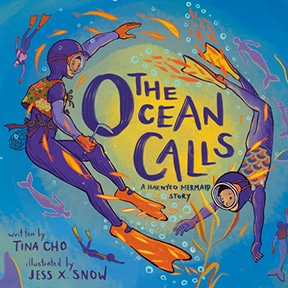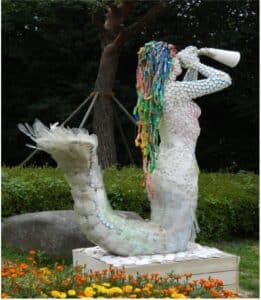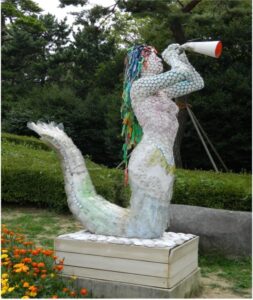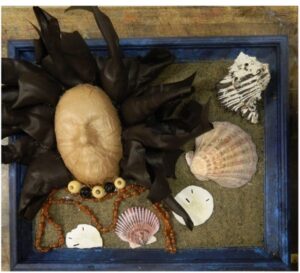
The Ocean Calls: A Haenyeo Mermaid Story
- Fiction
- Set in Korea
Keywords: ocean, swimming, environment, grandparents, courage
A breathtaking picture book featuring a Korean girl and her haenyeo (free diving) grandmother about intergenerational bonds, finding courage in the face of fear, and connecting with our natural world.
Dayeon wants to be a haenyeo just like Grandma. The haenyeo dive off the coast of Jeju Island to pluck treasures from the sea–generations of Korean women have done so for centuries. To Dayeon, the haenyeo are as strong and graceful as mermaids. To give her strength, Dayeon eats Grandma’s abalone porridge. She practices holding her breath while they do the dishes. And when Grandma suits up for her next dive, Dayeon grabs her suit, flippers, and goggles. A scary memory of the sea keeps Dayeon clinging to the shore, but with Grandma’s guidance, Dayeon comes to appreciate the ocean’s many gifts.
Tina Cho’s The Ocean Calls, with luminous illustrations by muralist Jess X. Snow, is a classic in the making.
This colorful children’s story, written by Tina Cho, shares the tradition of Korea’s treasure-hunting mermaids (haenyeo [HEH-nyaw]) through the experiences of a young girl, Dayeon [TAH-yuhn], and her grandmother. A woman who dives deep into the sea to gather marine treasures without using any breathing devices, Dayeon’s grandmother is not only an example of strength and perseverance, but also a symbol of dedication and teamwork. Grandma explains the value of the women who carry out this dangerous work off the coast of Jeju Island [CHEH-joo] and the importance of this tradition in Korean culture. Using an extraordinary palette of complementary colors, artist Jess X. Snow creates brilliant illustrations to express the emotions of young Dayeon as she works to overcome her fears and follow in her grandmother’s footsteps.
Through practice and perseverance, the young main character overcomes her fear of the sea. Dayeon is inspired by the women, most of whom are old, who learn the ways of the water and take only what is needed from “a garden of sparkling treasures.” Under the guidance of her grandmother, Dayeon learns to dive and return safely with more than just a physical treasure—she emerges, beaming with a sense of accomplishment.
While the book is targeted for young children from kindergarten through grade 3, its message and artistry speaks to older students as well. Teachers could use this story to present a number of social and emotional learning opportunities as young Dayeon learns to manage her emotions through the supportive relationship she has with her grandma. For elementary-school students, the story of overcoming fears and learning from one’s elders is important. For older students, this book can be used to introduce and illustrate historical, economic, and ecological themes for further exploration.
This story also lends itself to cross-curricular connections for a variety of grade levels, including social studies, science, and language arts. One classroom activity that could develop as an extension of this book is an exploration of the story of Seolundae [SAWL-moon-day], the mythical sea goddess who created Jeju Island. Many other creation stories in Korean folklore, such as the legend of Magohalmi [mah-GOH-AHL-mee], would also provide students with opportunities to explore the natural landscape of the Korean peninsula through literature and geography.
From a historical perspective, students could explore how some of these gifts from the sea were used as tribute payments for the kings of the Joseon Dynasty [choh-SUHN], which ruled Korea for over five centuries. These treasures sometimes made their way to China as another form of tribute payment, as illustrated in a scroll at the British Museum. By searching the collection of theNational Museum of Korea and the National Folk Museum of Korea, students could see how these items were used and find other objects used as tribute throughout the history of Korea. Additionally, a look into the Representative List of the Intangible Cultural Heritage of Humanitycould provide the opportunity to learn more about the lives of haenyeo today and to explore other traditions as well.
Several lessons can be derived from a deeper look at the economic role played by these breadwinning women divers who often form business cooperatives for support. The haenyeohave been invaluable in taking care of the needs of their families, and diving is just one part of the picture. Using abalone as an example, students could investigate the many products derived from this marine mollusc and the markets for those products. They could also look at the role of the bulteok [POOL-tawk], a central gathering location for the haenyeo, and identify some of the ways the women of these diving communities support one another. In addition to spending time at sea, these women are also farmers and tend to the needs of their families while many of the men are away, serving in the army or out at sea, fishing. A comparison might also be made between the haenyeo of Korea and the ama [pronounced: AH-mah] of Japan, another group of female divers who risk their lives to carry on a tradition. *Note: Some online photo resources of the ama may not be appropriate for school-age children.

Connections to this story can also be made in the science classroom. By examining the lunar calendar and exploring high and low tides, students can figure out the best times for these women to do their work, and when it would be most dangerous. Students could write a report on one of the sea creatures collected by these treasure-hunting mermaids—octopus, sea cucumber, abalone, seaweed, turban snails, sea urchins, conch, and more. They could describe the marine ecologysurrounding Jeju Island, sometimes referred to as “Korea’s Hawai’i.” Classes could also learn how these sea creatures are featured in the cuisine of the island.

Thinking as conservationists, students might examine the environmental impact of pollution and its effects on both marine life and the lives of the haenyeo. The sign next to this contemporary sculpture located on Busan Beach on mainland South Korea explains:
Hello. I’m princess Cordelia Pet from Plastic Island, a big island country in the Pacific. Plastic Island consists of great and small piles of plastics, and is 7 times bigger than the Korean Peninsula. The reason I’m visiting Haeundae is that the amount of Korean plastics consumption runs to 108 kilograms per capita, twice bigger than the world average, and a great deal of the plastics is washed away to our country. It pains me deeply that whales, turtles, and albatrosses are suffering. Besides, even small oceanic organisms such as mackerels, squids, and shrimps are taking microplastics recently. You may not be able to eliminate plastics completely for the present, but can keep them from being swept away to sea. I ask for your interest and support for the sake of you, marine animals, and my country.
–Yours truly, Cordelia Pet, an emissary of the Plastic Island, August 2015
Inspired by the book and this work of art, students could investigate issues around ocean pollution and compare the size of “Plastic Island” not only to the Korean peninsula but also to Jeju Island, where this story is set. Students could use recycled materials to create their own environmental messages. They could become advocates for cleaner seas and a safer way of life for those women who are carrying on the centuries-old tradition of the haenyeo. Across grade levels and disciplines, The Ocean Calls provides teachers and students with a multitude of ways to learn more about Korean life through a memorable exploration of the sea.

Language Arts Standards:
- ELA-LITERACY.RL.3.3: Describe characters in a story (their traits, motivations, feelings) and explain how their actions contribute to the sequence of events.
- ELA-LITERACY.RL.3.7: Explain how specific aspects of a text’s illustrations contribute to what is conveyed by the words in a story (for example, do they create mood, emphasize aspects of a character or setting?)
Science Standards:
- K-ESS3-1 Earth and Human Activity: Use a model to represent the relationship between the needs of different plants and animals (including humans) and the places they live.
- 4-ESS2-2 Earth’s Systems: Analyze and interpret data from maps to describe patterns of Earth’s features.
- 2-LS4-1 Biological Evolution: Unity and Diversity: Make observations of plants and animals to compare the diversity of life in different habitats.
Visual Arts Standards:
- VA:Cr1.1.4a: Brainstorm multiple approaches to a creative art or design problem.
- VA:Cr1.2.3a: Apply knowledge of available resources, tools, and technologies to investigate personal ideas through the art-making process.
- VA:Cr2.3.4a: Document, describe, and represent regional constructed environments.
Author: Angie Stokes, 7–12 studio art and art history teacher, Wayne Trace Jr./Sr. High School, Haviland, Ohio
2021
Real-life Aquawomen: The Haenyeo by Haedam Lee and Yeonji Joo, New York Times, May 31, 2022
Fall 2020 Kids’ Indie Next List
Kirkus Best Children’s Books 2020
Junior Library Guild selection
